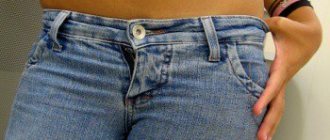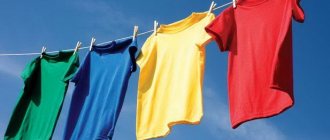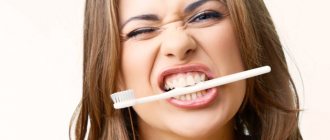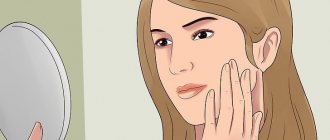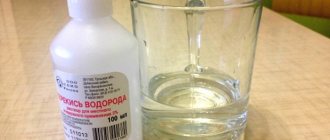Methods for bleaching laundry
If you wash a white sheet with a colored pillowcase, it may become stained. To avoid losing white items, never wash them with colored items. White fabric may also turn gray or yellow over time after frequent washing. This is due to the fact that some powders, when interacting with salt water, turn the fabric gray. If light-colored clothes are stored in a dirty laundry basket for a long time, they will inevitably darken. Therefore, it is recommended to wash light-colored clothes immediately.
Aspirin
Using regular aspirin you can get rid of the yellowish color on clothes. To do this, dissolve an aspirin tablet well in warm water and soak dirty clothes for one hour. Then wash with regular powder.
White
Previously, our grandmothers bleached snow-white linen only with this chlorine-containing product. It is an aggressive chemical, so it is not recommended to bleach any delicate fabrics. You only need to work with it while wearing rubber gloves and make sure that it does not get on the carpet. Keep bleach sealed and away from pets and children.
One tablespoon of white is enough for 3 liters of water. The item to be bleached is soaked in it for 30 minutes, then it is taken out and rinsed thoroughly in clean water. If you leave an item in a basin with white for more than half an hour, the fibers may become deformed. If the fabric is too dirty, then it can be boiled in this solution for no longer than an hour. After which the laundry is rinsed several times in clean water.
Boric acid
It equally effectively removes grayness from white fabric both when boiling and in the washing machine. Pre-soaking works best. Add 2 teaspoons of boric acid to a liter of warm water. Then dirty clothes are soaked in it for no longer than two hours, then washed in any way.
Bleach "Persol"
This product has a mild effect, so it is ideal for all types of fabric. When combating dirt, it does not spoil the fibers of the fabric, which means it does not disrupt its structure. You can even wash children's clothes with it, since it does not contain aggressive chemicals that cause allergies. Persalt can be used in both cold and hot water, even in the washing machine.
Baking soda
Even without boiling, you can return dirty canvas to its original whiteness. To do this you will need ordinary baking soda. It can not only effectively remove dirt, but also preserve the structure of the canvas for a long time. The product is safe for the skin, so experienced mothers prefer to use it to return the white color to their children’s clothes.
Pour 2 tablespoons of soda into a two-liter bowl of water and add a tablespoon of ammonia. Then the clothes are soaked in it for about 3 hours, and then washed in the usual way. If the item is very dirty, then you can boil it in this solution for about half an hour.
There is an effective way to remove stains from clothes. The stain is moistened, covered with a thick layer of soda and poured with vinegar. In three minutes there will be no trace left of the stain.
Hydrogen peroxide
With this effective product you can whiten even delicate fabrics. It will help you easily get rid of yellow spots in the armpits. To do this, apply a 3% solution to this area for 10 minutes, then wash it by hand or throw it in the washing machine. If these spots have not gone away, but have become a little weaker, then this method must be repeated several times until the bitter end. And do not be afraid of deformation of the fabric.
To remove dirt, pour 2 tablespoons of hydrogen peroxide and ammonia into a ten-liter bucket of hot water. Then the dirty fabric is soaked in the solution for about 30 minutes, after which it is washed in the usual way.
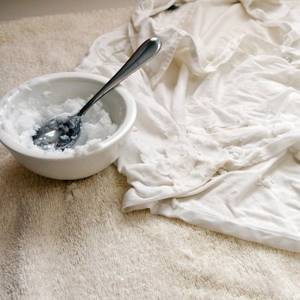
Vegetable oil
Very dirty and greasy fabric, such as a kitchen towel, can be washed with vegetable oil. Add 3 tablespoons of washing powder, oil and bleach to a bowl of warm water. Dirty laundry is kept soaked all night, and in the morning it is first rinsed, then washed in the usual way.
Eggshell
If a thing has become grayish over time, you can lighten it using ordinary eggshells. To do this, grind 100 grams of eggshells, pour them into a regular fabric bag and place them in the drum of the washing machine along with dirty laundry. After washing, the laundry will again become dazzling white.
Why does white turn gray when washed in a machine?
First, you should figure out why, after washing, white linen becomes gray, that is, dirty, instead of being cleaned and brightened?
First, you should exclude gross violations of the washing rules: do not wash light-colored underwear with dark clothes, do not simultaneously wash smooth fabrics with those that can leave lint (such as angora knitwear), shake out sand, dust, crumbs and other loose particles from contaminated items, and etc.
But now you load, for example, snow-white bedding into the drum, and take it out “washed.” Why?
It's all about the temperature difference between washing and rinsing.
Washing is done in hot water - thanks to this, fat-containing microparticles of dirt “stick off” from the fabric and remain in the water. At this stage, your items are white and clean. But then the rinse cycle begins - standard rinsing modes usually require cold water to be poured into the drum. Meanwhile, dirt flakes do not completely drain off with the “washing” water - they stick to the walls of the drum and to the same things, because cold water stops the flotation process of hydrophobic particles. This is the same effect that prevents you from washing greasy dishes in cold water.
As a result, dirt, which was locally on the items before washing, settles on their entire surface, also penetrating quite deeply into the structure of the fabric fibers. Added to this may be dirt from previous washes remaining inside the washer.

When checking the laundry after washing, we notice that it has changed color and looks stale
Adviсe
- Chlorine bleaches should not be used frequently as they can destroy the fibers.
- Don't be lazy and wash light-colored items separately from dark-colored ones.
- Before washing with bleach, you need to check for rust stains on your clothes. Otherwise, the bleach will multiply these stains.
- If clothes have metal buttons, they cannot be washed at temperatures above 40 degrees.
- If there are chips on the enamel basin, then it is not recommended to carry out the bleaching procedure. It is better to choose a plastic basin.
- Before the lightening procedure, it is recommended to read the labels on clothing. If the label has a triangle crossed out by two lines, it means that this item cannot be bleached, otherwise it will lose its presentation.
How to bleach white clothes
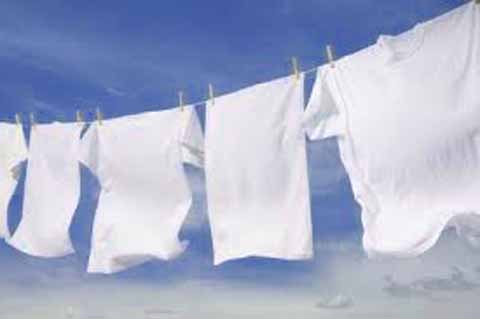
I really like white things. However, they often lose their attractive appearance and become gray, as if washed out. How to whiten white things, return them to an attractive appearance, and remove gray plaque. Today I will share my secrets of snow-white underwear. I have certain washing rules and 5 bleaching methods. Choose whichever one is more suitable, there are different methods for different things.
Method one - boiling
This is a proven method of our grandmothers. Can be labor intensive, but has never failed. This is how you can bleach cotton linen. If there is a lot of laundry, then we put it in a boiler (a sick enamel pan), if it is smaller, then in an enamel bucket or an enamel basin, fill everything with water and add washing powder. Place the container on the stove and boil for 30 minutes, periodically turning things over with wooden tongs.
Method two - use salt
This method is suitable for getting rid of grayish plaque on synthetic fabrics.
You just need to soak them for 20 minutes in warm salt water (2 tablespoons of salt per 1 liter of water). After this time, rinse and wring out the items.
Method three - use laundry soap
Here it is better to use the most concentrated laundry soap - 72% (indicated directly on the piece in the form of an imprint). Soak the item in cold water for 2-3 hours, then thoroughly soap it and fill it with hot water, whip up the foam and leave the item in it for an hour. Then we wash it by hand.
If you put baking soda in the water when washing, the water will become softer, and a gray coating will not form on things when washing.
Laundry soap will help remove sweat stains on a white blouse.
To do this, you need to soak a white blouse for 3 hours in a special solution (dilute 3 tablespoons of grated laundry soap and 1/3 cup of ammonia in 2 liters of warm water), then rinse well in warm water.
Method four - use hydrogen peroxide
It helps whiten yellowed items. Add 3 tablespoons of hydrogen peroxide to 10 liters of water and immerse the yellowed laundry there for 30-40 minutes. Then rinse thoroughly and be sure to dry in direct sunlight (they will help the final whitening).
Hydrogen peroxide can be replaced with hydroperite: 9 tablets are enough for 10 liters of water (you can buy it at the pharmacy).
Method five - use boric acid
Ideal for whitening socks, golf, T-shirts.
They need to be soaked for 2 hours in warm water in which boric acid is dissolved (2 tablespoons per 4 liters of water). Boric acid can not only make things snow-white, but is an excellent fungus prevention.
I would like to remind you of 2 more important rules for proper washing:
White linen and cotton items should not be washed together with woolen and synthetic clothes. Otherwise, white things will take on a gray appearance.
You can bleach clothes no more often than after 3-4 washes, otherwise they will lose their strength.
Today you learned: how to whiten white things using 5 different bleaching methods.
They will help your things be perfectly white. Share the article on social media. networks:
Traditional methods
Hydrogen peroxide 3%
2 tbsp is enough. l. They are mixed in equal proportions with soda and diluted in 2 liters of warm water, then the item is immersed in the solution.
Soaking should last about 40 minutes. After which the product should be rinsed.
For maximum effect, ammonia is also added to the peroxide. This solution perfectly eliminates the grayish tint.
You can get rid of stubborn stains on clothes by pouring hydrogen peroxide over the problem areas for 20-30 minutes. After this, the product is washed completely with bleaching powder.
White
Effectively returns white clothes to their original appearance. The product can be purchased in liquid or powder form.
It is diluted in accordance with the manufacturer's instructions on the packaging and the item is soaked in the solution for 20-30 minutes. Then the product should be thoroughly rinsed with cool water and only then washed as usual.
Important! The chlorine bleach method is not recommended for frequent use. Only cotton items can be bleached.
Baking soda
Effective when soaking and boiling. It, together with washing powder, is added to the container in the amount of 3 tbsp. l.
For bleaching, prepare a solution of soda and peroxide and soak the product in it before washing.
Expert opinion
Irina. Housewife.
Ask a Question
2-3 tablespoons of soda can be poured into the drum of the washing machine before starting the program. An affordable and harmless product suitable for treating both adult and children's clothing.
Boric acid
The drug is sold in pharmacies and costs a penny. It is successfully used by housewives to solve many household problems.
Boric acid is added to the soaking water at the rate of 1 tbsp. l. per liter The item is immersed in the prepared solution for a period of 30 minutes to an hour. After this manipulation, the product must be rinsed well.
This method is not suitable for bleaching synthetics.
Expert opinion
Irina. Housewife.
Ask a Question
Important! In addition to bleaching properties, boric acid has a disinfecting effect.
Blueing
Most products turn yellow or gray over time as a result of fibers burning out. In this case, bleaching will only worsen the situation.
You can return things to an attractive appearance with the help of bluing. It is sold in supermarkets and household chemical stores.
- Dissolve the blue in water at room temperature until smooth according to the instructions on the package.
- In the resulting mixture, soak a clean, washed T-shirt for 1-2 hours.
- Then rinse with cold water.
Laundry soap with potassium permanganate
It's hard to believe that manganese can be used as a bleach. In tandem with laundry soap the result is simply amazing.
Add ¼ of a bar of soap to boiling water and stir until completely dissolved. When soap suds form on the surface, manganese is added to the composition.
The product should be placed in a container with this mixture for 40-50 minutes. Then wash as usual.
Important! Manganese is added in such an amount that the composition acquires a pale pink tint. In this case, you need to wait until the crystals are completely dissolved.
Laundry soap and Vanish
The effectiveness of the popular industrial bleach will be enhanced by shavings of laundry soap. There are different options for using the mixture:
- soaking clothes for 40-50 minutes in a solution of soap shavings, Vanish and water;
- washing with Vanish in the machine;
- treating stains with bleach and washing with soap under the tap.
Both products lighten yellowed products well, and combined use improves the result.
Manganese
Manganese crystals dissolve in lukewarm water. It is important to wait for complete dissolution (otherwise there is a chance of getting unsightly brown spots on the fabric) and place the item in slightly pink water for 2-3 hours.
Do not exceed the dosage of potassium permanganate so that the material does not acquire a pink tint.
Ammonia
This product has been popular as a stain remover in the most difficult situations since Soviet times. Ammonia is used to treat items of clothing, combining it with other components.
Ammonia + turpentine + laundry soap
Old stains on grayed things will be removed by a mixture of components such as:
- ammonia - 1 tbsp. l.;
- turpentine – 2 tsp;
- laundry soap - 40 g of shavings.
All ingredients must be mixed and diluted in warm water. Then immerse the clothing in the resulting solution. It is allowed to pre-apply the mixture to problem areas for 10 minutes.
After the procedure, the linen is washed in the usual way. Please note that this method is not recommended for thin fabrics.
Salt
It is combined in equal proportions with ammonia and the product is treated with this mixture. Then leave until completely dry. Then you need to evaluate the result and repeat the procedure if necessary.
The substance removes unpleasant odors and is suitable for boiling. For wool and silk products, it is better to choose a different bleaching method.
Petrol
In purified form, apply to problem areas using a cotton pad. It is alternated with ammonia. After treatment, the T-shirt must be washed in the usual way.
Medical alcohol
In equal proportions with ammonia, apply to the area with yellowing repeatedly until the desired result is obtained.
Mustard
Mustard powder must be dissolved - 1 tbsp. l. for 1 liter of hot water. The product is soaked in the resulting mixture for approximately 40 minutes.
This product perfectly whitens and disinfects things, and also gets rid of greasy stains. Therefore, this is an ideal way to keep your kitchen towels clean.
Expert opinion
Irina. Housewife.
Ask a Question
Important! The solution should be filtered before use.
Acetylsalicylic acid
This intricate phrase refers to the familiar “Aspirin” to everyone. 10 tablets are dissolved in 2 liters of warm water, temperature 40-50 degrees.
Then the item should be kept in the resulting composition for about an hour and the result assessed. Repeat if necessary.
Lemon acid
2 tbsp. l. The powder must be diluted to a thick sour cream. The resulting paste should be applied to yellowed or contaminated areas of the product and left for 20-40 minutes. Then rinse and only then wash in the washing machine.
Important! It is permissible to replace citric acid with vinegar or lemon juice.
Boiling
It’s worth starting with the information that boiling is only suitable for cotton fabrics. Items made of wool or synthetics cannot be treated with this method. Boiling in boiling water involves the following steps:
- fill a large container with water;
- add detergent;
- put on gas;
- bring water to a boil;
- leave the container on the fire for approximately one hour.
When boiling, for greater effect, use soda, powder, laundry soap, hydrogen peroxide, and table salt. During this procedure, it is recommended to open the windows, especially when using a chlorine product.
Baking powder or starch
You can return things to their original whiteness by adding 2 tbsp to 5 liters of water. l. baking powder or starch. This substance is also poured directly into the washing drum before the start of the cycle. Housewives note that such a simple product as baking powder is useful not only for baking, but also for bleaching shirts.
